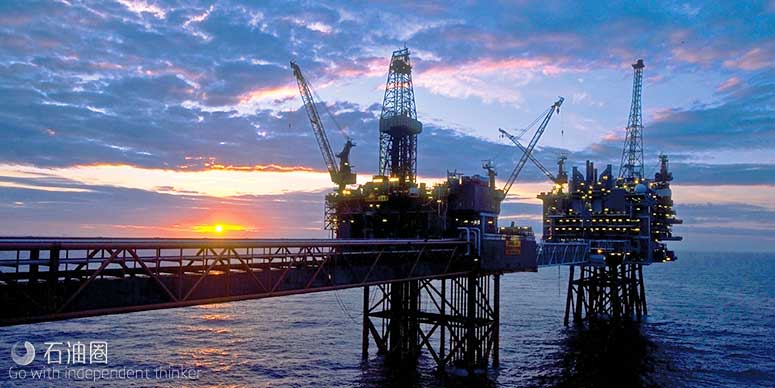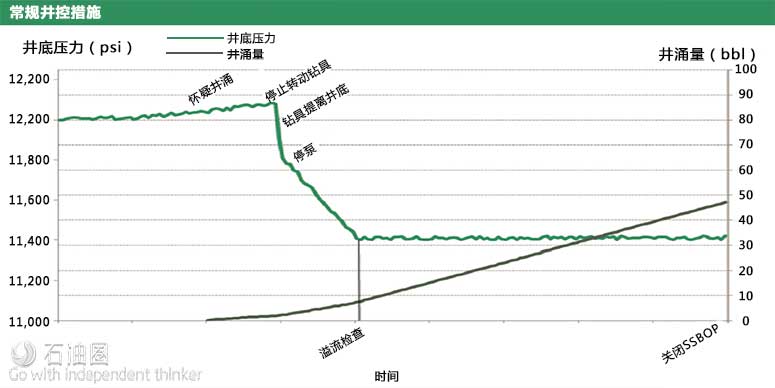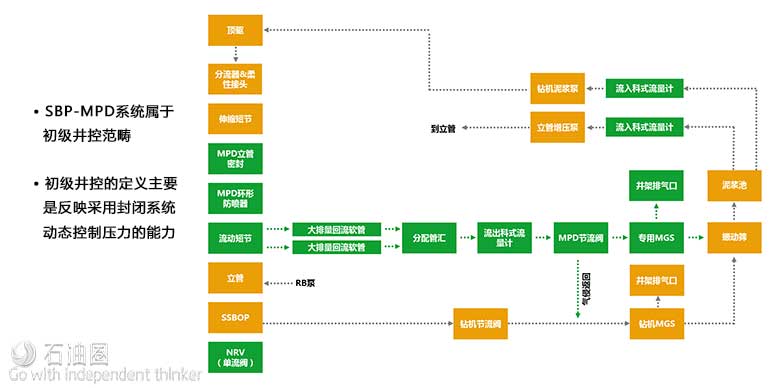Well control in deepwater drilling operations often is overmatched. In this challenging environment, a wellbore influx sets in motion a decades-old and increasingly insufficient response that has its roots in much more benign applications.
Experience makes it apparent that drilling from floating rigs in deeper waters and unpredictable pressure regimes too frequently exceeds the basis of conventional well control philosophy. That line is clearly defined by a litany of risks, including large kicks, stuck pipe and riser gas, and their contribution to greater safety concerns and higher nonproductive time and project costs.
These limitations are addressed by augmenting conventional deepwater well control with applied surface backpressure-managed pressure drilling (ASBPMPD). The use of this methodology redefines the primary well barrier to include a closed circulating system with the capability to dynamically and rapidly control wellbore pressure. Implementation favorably resolves many conventional well control limitations with new capabilities such as rapid kick detection and response and the ability to safely circulate an influx out of the wellbore and riser.
An open and closed case
In conventional well control, the subsea BOP (SSBOP) is closed once the rig crew has confirmed that an influx has been taken. This is a proven response in standard drilling operations, but up against unique deepwater demands, its slower execution, imprecision and mechanical limitations are proving to be less effective.
When an influx is detected or suspected, the first step is to stop rotating the drillpipe, pick up off bottom and space out tool joints relative to the SSBOP rams. Mud pumps are then stopped in advance of a static flow check. The result is a loss in time and a significant reduction in bottomhole pressure (BHP), which brings the well further underbalanced and, in a step backward, increases the influx volume.
The static flow check to determine if the well is flowing takes critical time and must consider masking factors such as vessel motion and wellbore breathing. Meanwhile the wellbore remains open to the atmosphere and risk increases.
This is all a prelude to actually securing the well and stopping the influx by closing the SSBOP. And with it closed, other concerns arise. As cuttings settle they threaten costly stuck-pipe events, and circulating through a small inside diameter (ID) choke line results in wellbore backpressure that can cause lost circulation. Furthermore, if an influx is large enough to exceed kick tolerance, closing the SSBOP does not stop the influx. In this case, an exposed, weaker formation becomes fractured, enabling hydrocarbons to continuously displace drilling mud from the wellbore. Riser gas also is a threat as an influx dissolved in oil-based or synthetic mud systems comes out of solution above the closed SSBOP.
Riser gas is a unique deepwater threat. With increased water depth comes a longer riser and higher hydrostatic pressure. In these circumstances, with an oil-based or synthetic mud in the hole, a hydrocarbon influx at formation depth may not break out of solution until it is circulated undetected above the SSBOP.
The high-intensity outcome is a riser unloading event that discharges mud and gas through the rotary table with little prior warning. In low-intensity events, the diverter packer may be closed in time to divert mud overboard, which may create an environmental event.
MPD system
ASBP-MPD equipment and processes resolve these conventional well control limitations by enhancing the primary hydrostatic barrier with rapid, accurate wellbore pressure control. This is achieved by integrating an assembly of drilling chokes, flow-in and flow-out measurement and a continuously sealed wellbore and riser with the rig’s system.
Flow within this closed system begins when the subsea MPD riser sealing system or MPD riser annular diverts flow to the topside MPD equipment via a subsea flow spool and mud return hoses. A distribution manifold at the surface directs riser flow to a MPD manifold, which consists of drilling chokes and Coriolis meters. Returns are processed through a dedicated MPD mud gas separator or the rig’s mud gas separator and ultimately routed to the shakers. Coriolis meters installed upstream of the rig pumps measure fluid flow rate and density into the well.
One form of a MPD riser sealing system is an active control device, which forms a wellbore seal around the drillpipe to establish a closed system and divert riser flow to the surface MPD manifold. The closed system enables dynamic adjustments to wellbore pressure, accurate flowrate measurement and safer mud gas separation.
AFGlobal’s active control device technology eliminates rotating components, energizes dual spherical BOP packers to close on a dual-seal element assembly, forming a wellbore seal. As the seal elements wear, hydraulic closing pressure on the annular packers actively adjust to maintain wellbore sealing integrity. The active control device also enables condition-based monitoring of the seal elements.
During routine replacement of a worn seal element assembly, wellbore pressure is trapped with the MPD riser annular BOP. Closing it continues to direct flow to topside MPD equipment. A flow spool installed directly below the MPD annular and MPD sealing system provides a redundant flow path for drilling returns. A distribution manifold directs return flow to the MPD manifold. It also provides overpressure relief protection, enables mud cap drilling technology and provides a tie-in for glycol/methanol injection.
The MPD manifold enables pressure control and measures flow from the well. Constant wellbore pressure is maintained with choke controls that use algorithms and hydraulic modeling software. The Coriolis meters installed upstream of each mud pump accurately monitor flow rate and density into the well. These data are used to quickly determine if a change in outflow or density is due to rig activity or wellbore influx.
Small gas influxes are handled using either a dedicated MPD mud gas separator or the rig’s well control separator. A FEED study must be conducted to assess and plan MPD operations within the limits of this component.
Drilling returns flow through high flow-rate hoses between the MPD riser flow spool and the topside distribution manifold. The large ID hoses are rated for multiphase flow and are specified to reduce frictional pressure loss.
Deepwater advantages
The key deepwater advantages of an ASBP-MPD system are confident, early kick detection and a rapid influx response, which lead to smaller influx volumes and the possibility to circulate an influx out of the well without shutting in the SSBOP.
An influx controlled within the primary well barrier may be safely circulated out of the wellbore without prematurely resorting to secondary well control. As such, a MPD influx circulation avoids excessive choke line friction and reduces the risk of stuck pipe by enabling circulation at higher flow rates and the ability to rotate and reciprocate the drillstring. Wear on the SSBOP from unnecessary use also is reduced.
Furthermore, kick detection and response are fast and accurate. Influxes are detected in gallons instead of barrels, and confidence is high enough to eliminate a static flow check. On detection, surface backpressure can be applied immediately in contrast to the lengthy conventional well control process. The riser is already sealed to protect against sudden riser unloading events.
Confident rapid kick detection is made possible by accurate measurement of inflow and outflow of the closed system. The use of Coriolis flowmeters and isolating outflow measurements from vessel heave helps reduce influx size and the reliance on a static flow check. Isolation is achieved by locating the MPD riser seal below the riser slip joint. Meters installed upstream of the pumps and on the downstream side provide direct measurements of the fluid flow rate and density to enable mass balance control.
In-hole sections where the MPD sealing system is inactive, the riser annular also may be used to augment well control.
Kick detection remains conventional, but once the riser annular is closed, an influx can be controlled and circulated from the well through the topside MPD equipment instead of resorting to the secondary barrier. This mitigates excessive choke line friction and stuck pipe and allows low-intensity riser gas events to be addressed without diverting overboard. However, the most secure way to protect against sudden high-intensity riser unloading events is to drill with the MPD riser sealing system providing a continuous seal.
It should be noted that any use of the MPD system for influx management is done so within agreed upon engineering and operational limits. Such limits may be updated for the worst-case scenario in each hole section. In the event that these limits are exceeded, control of the influx is turned over to the secondary well control as always done in the past. A highly structured communication plan also is created to ensure a smooth transition between primary and secondary well control.

 石油圈
石油圈


